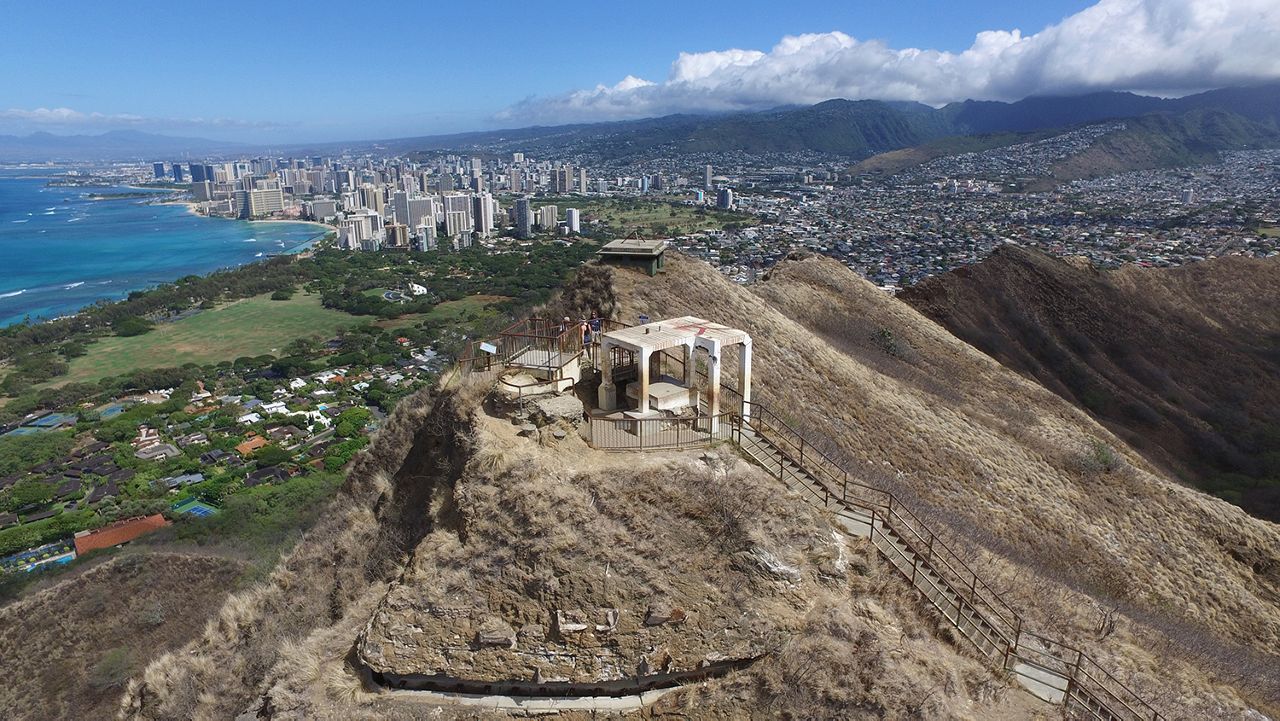HONOLULU — Leahi, commonly known as Diamond Head, is one of Oahu’s most popular and prominent visitor destinations that continues to draw travelers for its panoramic vistas.
The Diamond Head State Monument houses several military structures that are a part of the Fort Ruger Historic District. Two of them were constructed atop the historic Leahi Fire Control Station some time after the station was built in 1911. Work continues until mid-November near the summit, as both structures have been slated for demolition for safety reasons. Repairs are also being made to other structures.
A news release from the Department of Land and Natural Resources stated that the decision was made by the Division of State Parks due to concerns over safety and the high cost of repair.
“We looked at the cost of repairing or reconstructing these structures versus demolition,” said Alan Carpenter, assistant administrator with the DLNR Division of State Parks, in the release. “It was prohibitively [expensive] to repair or reconstruct them, particularly in the context of other park priorities.”
The entryway to the Leahi Fire Control Station begins at the top of the 99-step stairway. Repairs will be made to the concrete ceiling due to deterioration that could compromise the structure’s integrity.
During this time, monument staff say visitors will only be able to access three-fourths of the trail before having to turn around. The lookout will be inaccessible.
Referring to two column and slab roof structures added to the fire control array built between World War II and the early 1950s, Carpenter said people have continued to climb them despite posted danger signs and warnings to stay off them.
“We don’t want anyone to get hurt and this is a primary reason we elected to remove the structures,” he said. “The decision was made easier by the fact that they are not part of the 1911 structure, so in a way we are restoring the original feature’s integrity.”
Throughout the demolition process, protection will be provided for the other historic structures on the summit. The work meets historic preservation standards for significant historic buildings and structures.
In a follow-up release by DLNR, Carpenter shared what’s to come for the monument.
There are actually two tunnels leading into Diamond Head crater. Visitors by foot and in vehicles have used the Kahala Tunnel as the monument’s sole entry and exit point for decades. Carpenter wants to create a safer experience by opening the Kapahulu Tunnel, also referred to as the Mule Tunnel.
“The mule tunnel had rails in it initially and the materials needed to build features at the summit were pulled along the rail line by mules,” he said. “We’d like to spread cars and pedestrians out to make it safer for everyone, so we’re working on plans to reopen the Kapahulu Tunnel as the pedestrian-only entrance to Diamond Head State Monument.”
It’s still in the planning and design phase and several years in the making, but it’s a goal that Carpenter believes will improve the visitor experience and their safety as well. It will also provide historical features and a different view that visitors have been accustomed to seeing over the years.
“When you exit the tunnel, you have a magnificent vista looking up to the summit and the entire crater. People will pass another set of historic features along the way, so there are a lot of educational and interpretive values.”
According to DSP, many visitors walk from their Waikiki accommodations to the monument. The opening of the Kapahulu Tunnel will make for a longer trek when coming from the coastal Diamond Head Road, but a shorter one when walking along Monsarrat Avenue.
Future plans include a vehicle drop-off area and a connector from the street to the outside entrance of the tunnel.
A change taking effect sooner than the tunnel opening is a reservation system for the park in keeping with reservations being required for many popular destinations to control the flow of people, improve the visitor experience and maintain the areas and their natural ecosystem. The reservation system is expected to start sometime in early 2022.
After purchasing Diamond Head in 1904, the federal government designated it for military use and began work in 1908 to fortify the site. Fort Ruger was built in and around Diamond Head Crater to provide defense for the island and contained five batteries to hold artillery. Leahi Fire Control Station was completed in 1911. The fortification work was highly acclaimed as an engineering feat for its time.
Fort Ruger Historic District is listed on the U.S. National Register of Historic Places.



